If you had to guess which of Europe’s top five leagues had the most pressing in their games, you would be forgiven for guessing the Bundesliga, the home of gegenpressing, where Jurgen Klopp’s influence can still be seen across a plethora of games every week. The Bundesliga averages an 11.23 PPDA (that’s Passes Per Defensive Action), which ranks it as the third most intense pressing league out of the top five.
What about the Premier League then? The league has always sold itself on its end-to-end football where intensity is one of the key attributes of any premier league team. Again, in reality not quite so. The Premier League’s 11.67 PPDA ranks it fourth amongst the top five.
Ligue 1 finds itself at the bottom of the pile with a PPDA of 11.82, whereas the top two are compiled by Serie A at number two with a PPDA of 10.83, but La Liga trumps them all with a PPDA of 9.9.
It might not surprise many of you to hear that La Liga’s PPDA suggests this league has a high pressing intensity, but for it to be the number one league, and well clear of those league’s we traditionally associate with an intense style of play, certainly raises an eyebrow at least.
This tactical analysis and tactical theory piece will look at why the statistics paint this picture, and will give a brief analysis of some of the basic pressing tactics being used by the league’s three most intense pressing sides: Eibar, Sevilla, and Getafe.
Statistical overview
When you take a quick look at the pressing statistics of all of Europe’s teams in the top five leagues, it is suddenly very clear why La Liga has the highest pressing intensity out of these leagues. We know that their average PPDA is 9.9, and from Spain alone, Atletico Madrid, Granada, Athletic Club de Bilbao, Real Sociedad, Barcelona, Osasuna, Eibar, Sevilla, and Getafe, all have a PPDA under 10. That is nine teams from a total of 20 competing in La Liga. Compared to the third, fourth, and fifth ranking leagues in this metric, it makes surprising reading. Only two teams in Ligue 1 average a PPDA under 10, only five from the Premier League, and only six from the Bundesliga.
Another reason for La Liga being a statistical outlier in this metric can be seen when you look at the teams across Europe that press with low intensity.
If we were to take the twenty teams from across the top five leagues with the lowest pressing intensity, not a single team would come from Spain, with four coming from Germany, five each from Italy and England, and six coming from France.
Generally speaking, the majority of the league has at least a relatively intense press, and it is these teams with low pressing intensity that are bringing their league’s respective PPDA average down.
Nevertheless, it is clear to see that there is a pattern emerging in La Liga, and it is now time to look at the elite pressing teams from the Spanish league.
Pressing in Spain
There are plenty of similarities between the three teams I am going to look at, even though there are differences in their styles, and formations. Obviously the aim with any press is to win the ball-back at some point. This could be because a team feels it is particularly dangerous when winning the ball in higher areas, or because they want to prevent the opposition attack as early as possible. But every press isn’t revolved around winning the ball in these areas (although you won’t find too many teams that would be disappointed to win back possession within 30 yards of goal!). Teams will set traps to force the opposition into wider areas, and in these areas can close down a player’s passing options, and win the ball-back there, or a team may wish to frustrate an opposing side that like to build-up from the back, shutting off any forward passing options and ensuring the opposition are forced to either play the ball long, or make a mistake trying to play past the press.
Whichever way you look at it teams will press to impose themselves on the opposition and prevent them from being able to successfully carry out their game plan. Getafe, Sevilla, and Eibar, all have elements of the goals mentioned above in their pressing systems with each side having more emphasis on certain goals, however.
Before I look at any of these teams in detail, it is important to stress that all of these teams do elements of the tactics I am going to discuss, however, I am just choosing to focus on one aspect per team. They share similar principles with their pressing efforts and something that can be seen with every team is that they are flexible in their approach to pressing, as long as they can fulfil their pressing aims.
Eibar – blocking central play and nullifying the pivot
Eibar play a 4-4-2 formation, but are pretty fluid within this structure when out of possession. Although we will generally see them press with a front two, it is not unusual to see one of the wide midfielders step up to create a front three, like below.
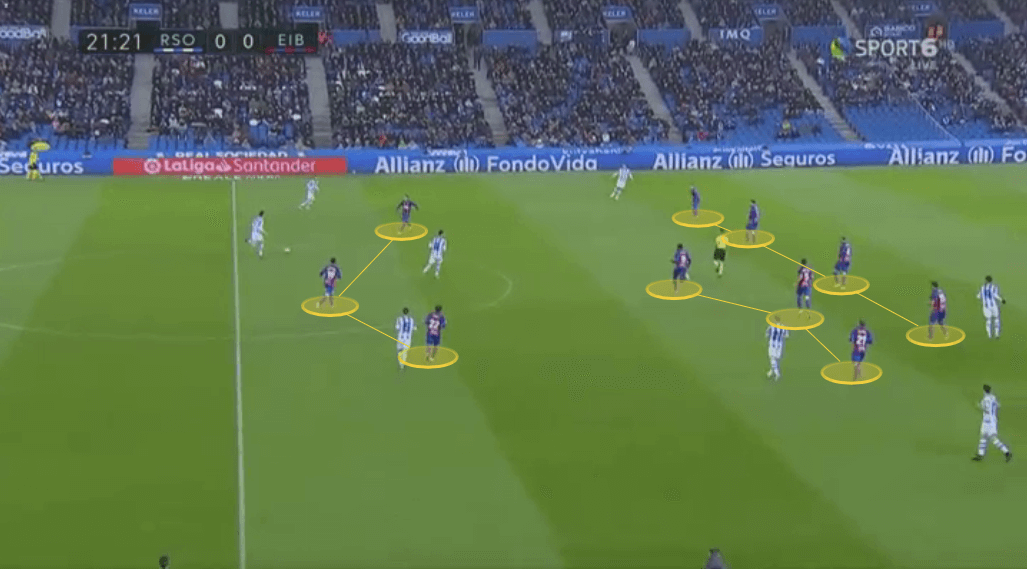
Eibar are very aggressive with their press and want to win the ball in higher areas to halt the opposition attack at the source, and counter quickly. If they can’t win it back they will force the opposition to have to play long, and seek to regain possession that way.
Most of the time we will see their centre-forwards pressing the opposition centre-backs, their wingers pressing the opposition full-backs, and their full-backs pressing the opposition wingers.
Eibar will allow their players in these positions to initially block passing lanes with their positioning, and as they go to press there is always an emphasis on continuing to block passing lanes with their body positioning and runs. All the while, Eibar’s central-midfielders will predominantly remain touch-tight on the opposition central-midfielders.
Eibar have a typical pressing set-up, and similar set-ups are seen with both Sevilla and Getafe.
The two forwards below are tight and clearly covering the Sociedad pivot, however, they are also close enough to the centre-backs to pressure them ensuring the centre-backs don’t get too much time on the ball. The wingers either side of the front two are tight to the midfield to prevent any central passes, whilst they are ready to press the opposition full-backs should they receive possession. The two central midfielders are man-marking their opposite numbers.
The arrows below show how quickly Eibar can move to press any given player, should they receive possession.
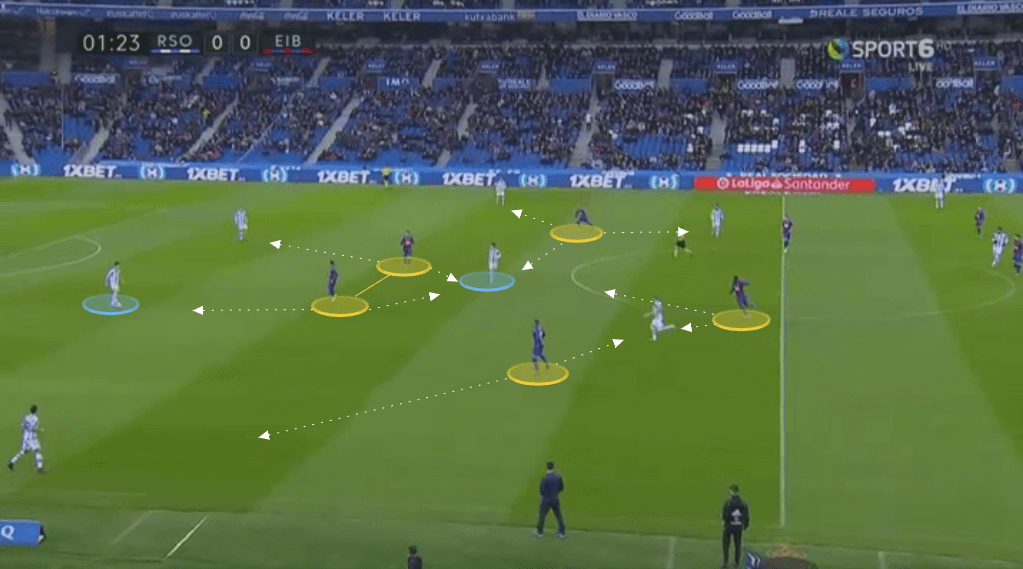
With such a set-up it means that the opposition pivot should be free to receive the ball centrally at some point, for he isn’t being marked by a midfielder. In the example above, Sociedad are playing with three central midfielders, whilst Eibar are playing with two.
With such a tight defensive formation, it is common to see the opponent, in such a situation, seek to continue looking to play out from the back and the obvious option in the image above is to play to the right-back. By playing to the full-back the opposition are, at least initially, committing to attempting to beat the press.
Eibar shift over as a unit at this point, and below there are two key movements we will see in other examples to come. Firstly the Eibar wide midfielder will curve his press to minimise the full-back’s options, ensuring they cannot pass inside, and is forced to go down the line. On top of this the right-sided centre-forward will drop deep and pick up the opposition pivot meaning the two central-midfielders don’t have to rush forward to pick him up.
This set-up below shows how Eibar seek to achieve their pressing goals. Should the opposition seek to play out, Eibar’s pressing shape is incredibly compact around Sociedad’s defensive and midfield options, meaning there is a good chance to win the ball-back in this area, and counter quickly, with plenty of players already in attacking options. The wingers have pushed up to support the press and ensure the opposition can’t circulate the ball using their back four. The pivot has been nullified due to the centre-forward dropping in, and the safest option here for Sociedad is to play the ball long and relieve the pressure.
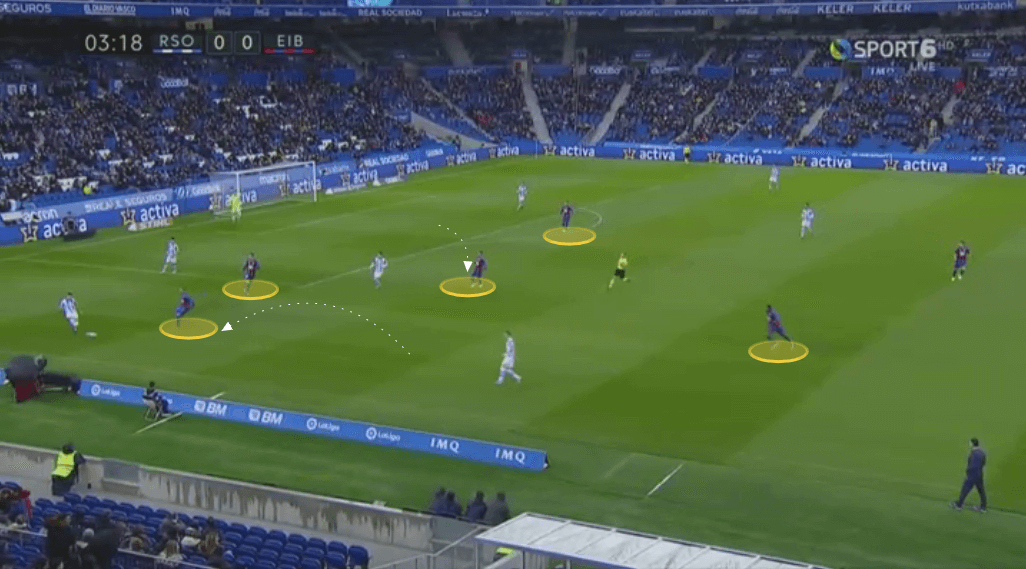
The image below shows this from a situation where Eibar’s press is more stretched. However, it shows us an excellent outline of their overall pressing shape again. With the ball with the opposition goalkeeper we can see the right-sided forward drops deep to pick up the pivot. The left-sided centre-forward has used his initial run to show the keeper to one side, and we can see both Eibar wingers pushing up to support the press of their forward line. Inside, once again, the central-midfielders are tight on their opposite numbers.
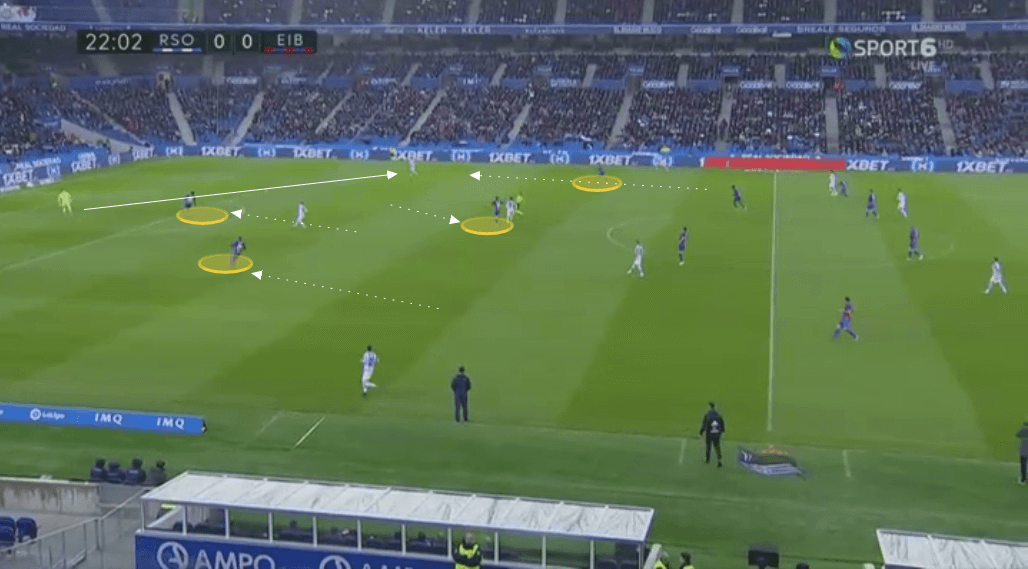
As intense as their press is, Eibar’s players are constantly using their runs and positioning to block passing lanes at all times. The image below highlights this as they aggressively press the opposition goalkeeper with three players. All three are able to block off four passing lanes, whilst Eibar’s three players in midfield are high in support to ensure there is no space for Real Sociedad to attempt to play past this press, and they are forced to go long.
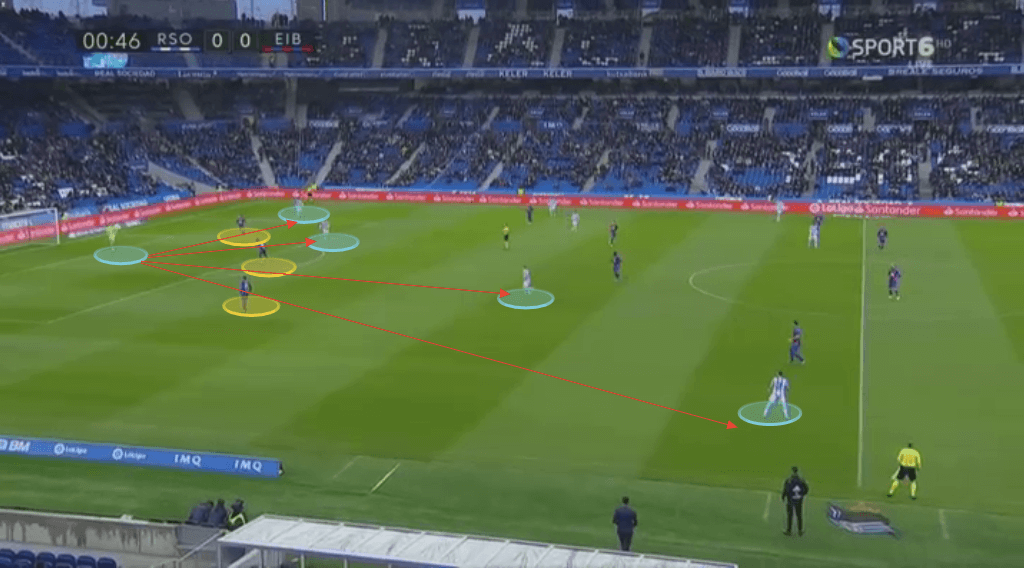
We can see another example of Eibar nullifying the pivot in a more advanced area in the sequence of two images below.
We can see that the left-midfielder is tucked in once more, protecting the central pass, whilst ready to press the right-back should they receive possession. We are able to see how Eibar are set up well to press any Sociedad player should they receive the ball.

As the ball is played to the Sociedad right-back, Eibar react. The left-midfielder presses him, his body positioning closing off a forward pass, whilst the centre-forward tucks back to prevent the pivot from receiving. Eibar’s central-midfielders stay deep, not sacrificing central space in their defensive third, and Eibar’s centre-forward, being close enough to drop in to pick up the pivot, allows them to do this.
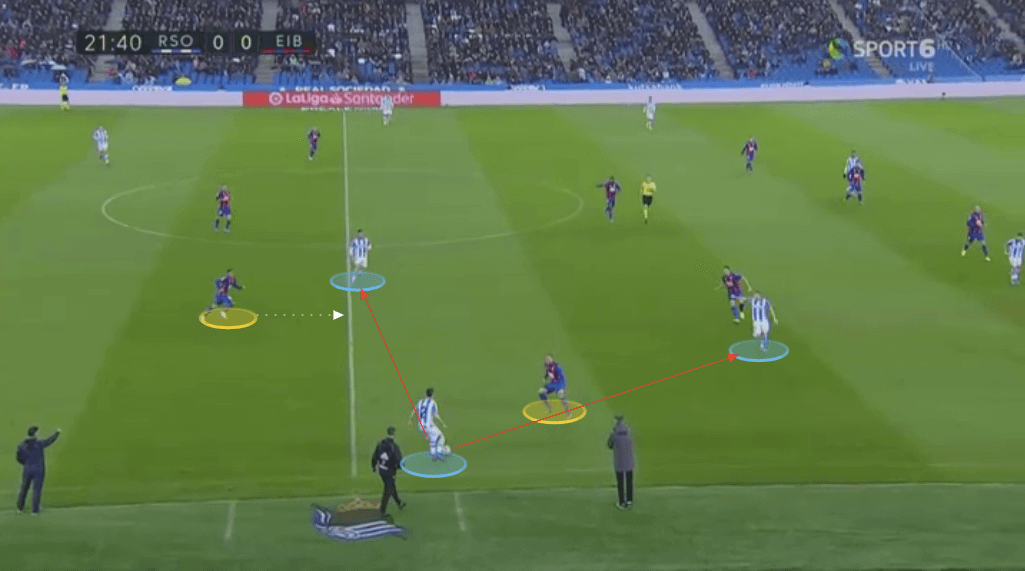
Sevilla – Forcing the opposition to play long, and counter-attacking
Sevilla have played a plethora of formations this season, but have used the 4-3-3 most frequently. I would argue they are as, if not more aggressive with their positioning than Eibar, but not in their intensity. Sevilla put a particular emphasis on pressing to close off areas of the pitch and passing lanes. They design their press to encourage the opposition to play long balls where Sevilla can quickly regain possession and continue to seek to suffocate their opponent with their excellent possession-based attacking football.
However, if they can win the ball back early, their shape allows them to counter quickly through the central channel.
Below we see the Sevilla centre-forward curve his run, closing off one side of the pitch.
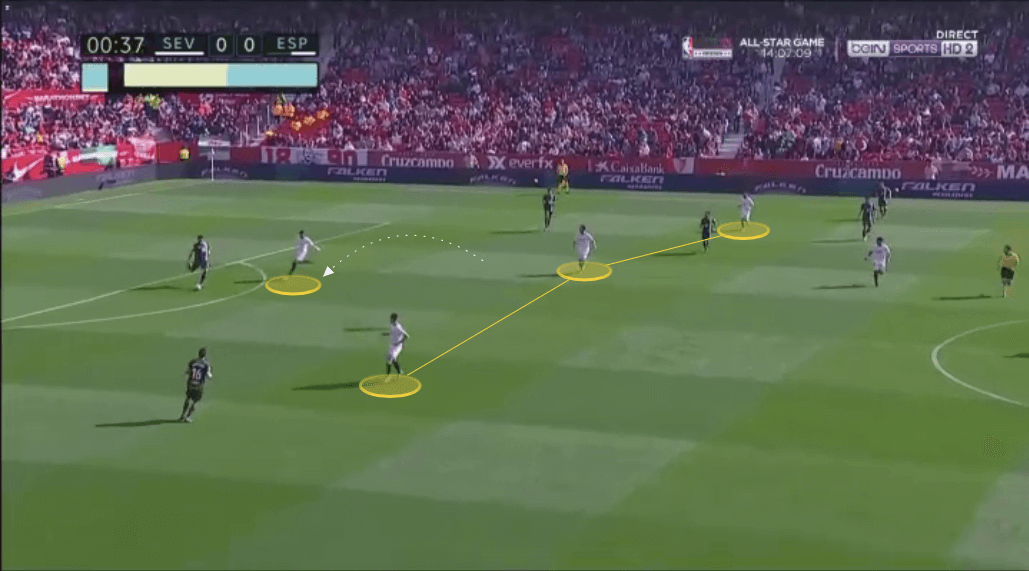
As the opposition play centrally and beat the press we can see how quickly Sevilla are around the opponent, and should the pressing central-midfielder dispossess the player or they have a bad touch, they are positioned to capitalise on this.
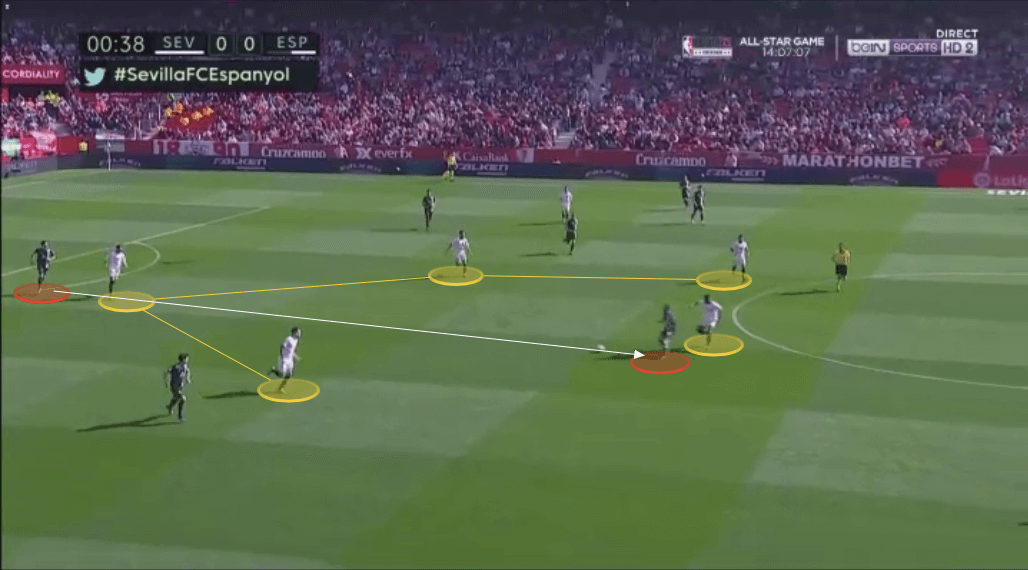
Sevilla’s press is generally led by one centre-forward, who is supported by three players in the second line of press behind him.
If the keeper plays to one of his centre-backs, this forward’s job is to close off one side of the pitch by angling his run and limiting the centre-backs passing options to either play forward, or to play to their closest full-back.
If the opposition beat the first line of press, Sevilla’s second line very aggressively look to push them back towards their own goal. Unlike Eibar, Sevilla are less concerned about leaving the pivot open initially, however, as soon as the pivot receives, then they press them intensely, forcing them to play backwards. They do this to force the centre-back to make a decision under pressure. Invariably the centre-back will choose to go long, which as I have mentioned, is something Sevilla want to encourage.
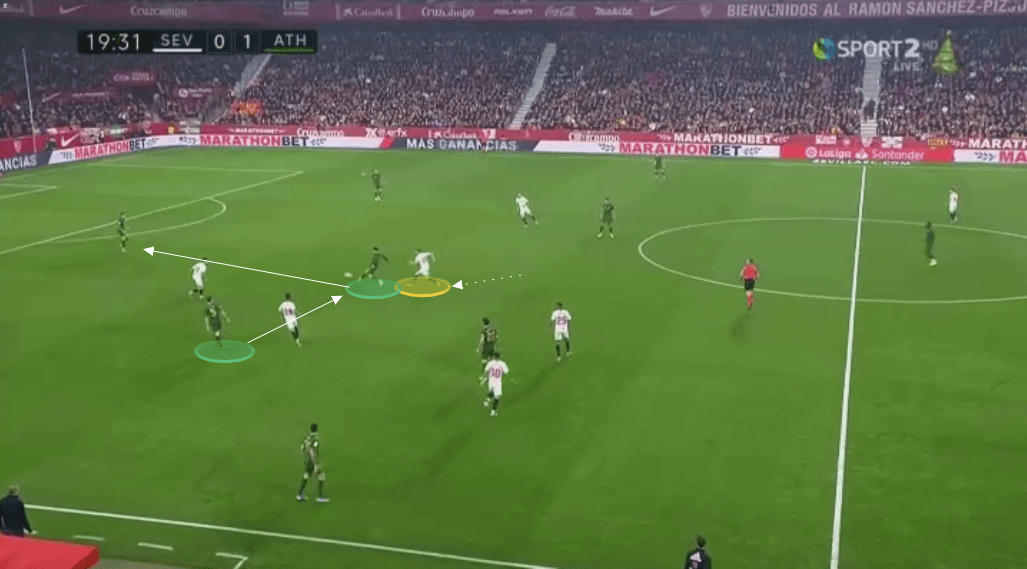
There are times where Sevilla press with a front two. The advantage of doing this is it limits a centre-back’s passing options either side of them and can once again force the opponent to play long.
We can see a perfect example of this below where the two forwards are blocking off lateral passing options for the centre-back, whilst Sevilla’s midfield are man-marking, meaning the centre-back can attempt a risky pass, but is far more likely to play it safe in this scenario and go long.
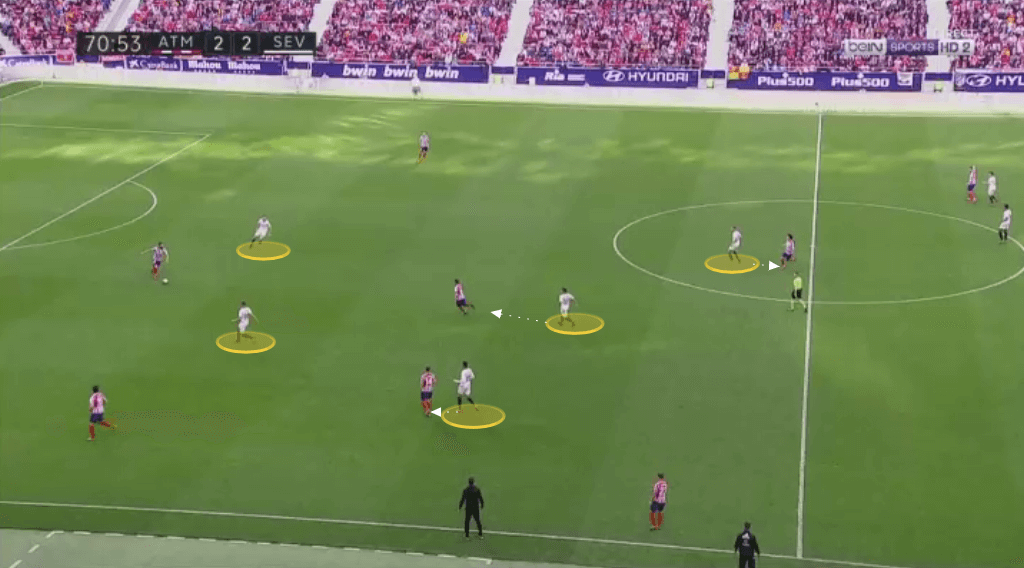
Getafe – pressing wide areas
Getafe press incredibly intensely, not just in the initial press, but across the pitch, whenever they engage an opponent who is in possession. If the opposition beat their press, Getafe use rotational fouling to stop the attack developing further.
Similarly to Sevilla, Getafe use a front two to block passing lanes when the opposition look to play out from the back. In the image below the front two are blocking the Real Betis centre-back’s passing lanes to the Betis left-back, right-back and other centre-back. Centrally we can see how they are man-marking the Betis midfield, and just like Sevilla and Eibar do, they are forcing the opposition to have to either play the ball long or attempt to break this set-up should they want to get the ball into their midfielder’s feet.
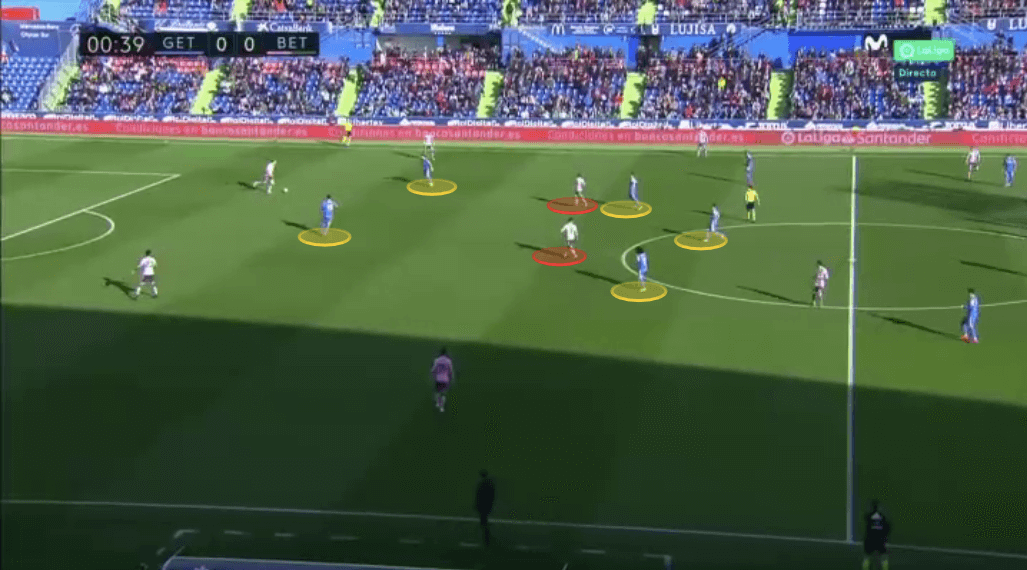
Getafe’s compactness forces the opposition to use the flanks to beat them, yet Getafe disguise their intention to push the opposition into these areas.
They want to push teams into wide areas, where they can close off any passing options and suffocate the opposition.
Below is an example of this trap. As the Betis left centre-back switches to his right-sided teammate, Marc Cucurella will push up from left-wing. He leaves Getafe’s two centre-forwards in position, meaning the centre-back is unlikely to play the ball-back to his centre-back compatriot. Cucurella curves his run to initially delay the pass to the full-back. If he were to press without curving his run and the right-back could receive instantly in this case, they would have time and space to help Betis continue playing forward. Cucurella’s run allows his team time to squeeze over as a unit, and the Getafe left-back pushes up to take Cucurella’s original space in midfield
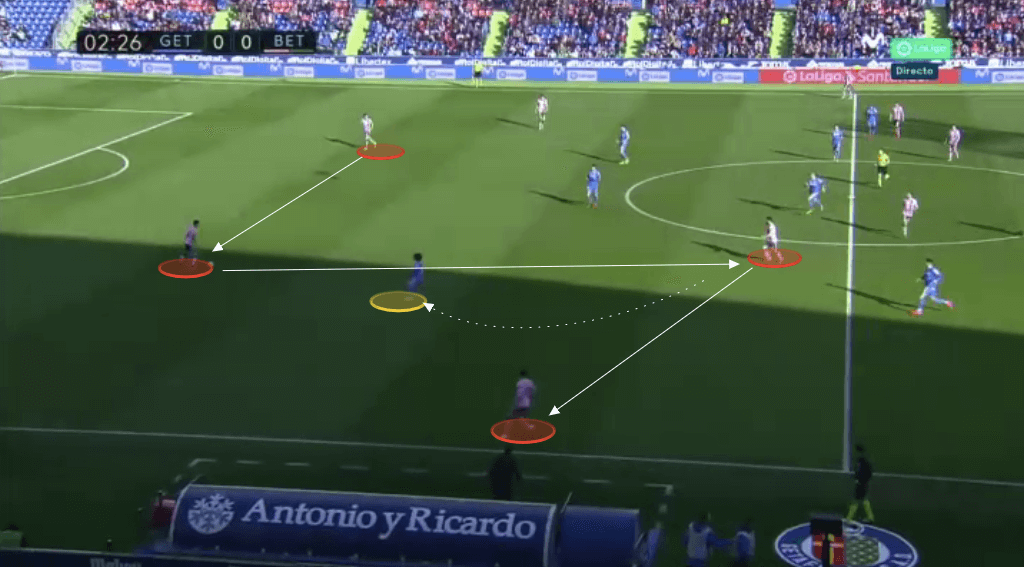
When Betis play into the full-back from the centre-midfielder we can see how compact their shape is in the image below. There is no option here for the Betis full-back then to play long. Cucurella has dropped in to provide pressure from the front, the Getafe centre-midfielder blocks the lateral option, whilst both Getafe’s left-back and centre-back push up to prevent Betis from playing the ball on the floor. It has to be a ball over the top, which Getafe can sweep up and begin their own attack. It is also worth noting that Getafe’s two centre-forwards are in excellent positions should their team win the ball-back in this wide area, to orchestrate an effective counter-attack.
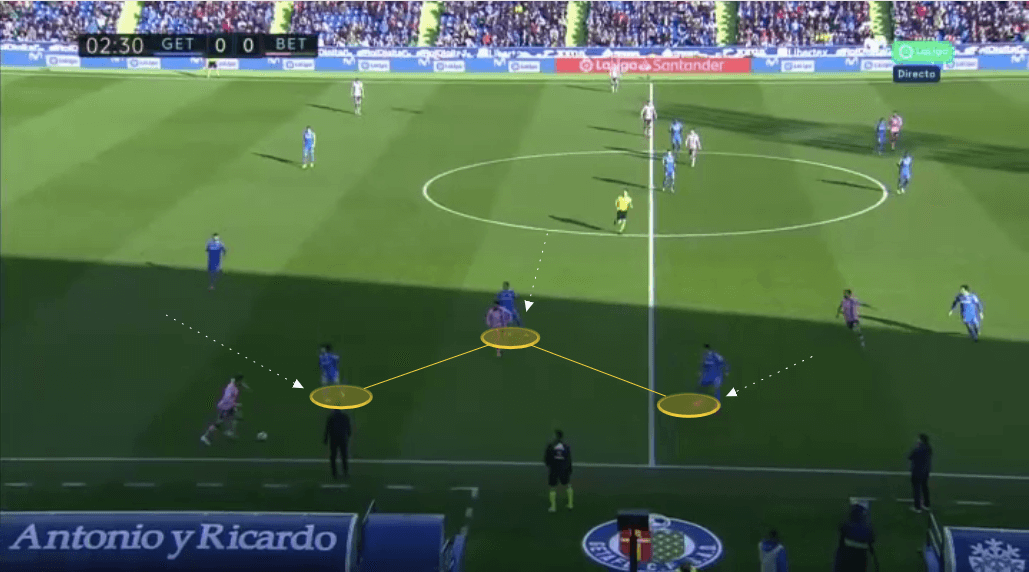
Conclusion
This is merely a brief whistle-stop tour through pressing in La Liga, and all of the teams mentioned will cover the aspects of pressing this article details, but it is interesting that these teams should be so similar in their approach, have similar pressing numbers, yet, certainly in the case of Sevilla compared to the other two sides, they aren’t necessarily similar sides.
There are of course reasons the data may read this way. Ball progression in La Liga is particularly low, which definitely leads to high pressing. Getafe, Leganés, Granada, Alavés, Espanyol and Eibar all rank in the bottom ten in Europe for progressive runs, and Atletico Madrid are low as well. La Liga has the lowest rate of passes per minute too, which similarly would benefit a high pressing system. There is a distinct lack of pass progressors in the league in general. La Liga ranks fourth out of the top five leagues for progressive passes. So is it the style of play leading to pressing, or the pressing leading to the style of play?
Either way, it is interesting to take a glance at some of Europe’s most intense pressing sides and to see that really what they are doing is very basic, but they are doing it very well, and with a great deal of commitment.





Comments